In this article, you’ll learn what is a spark plug, how it works? different types of spark plugs, working, requirements, how to clean, and more.
Also, you can download the PDF file of this article at the end of it.
Spark Plugs and Types
What is a spark plug?
The spark plug is a device that produces an
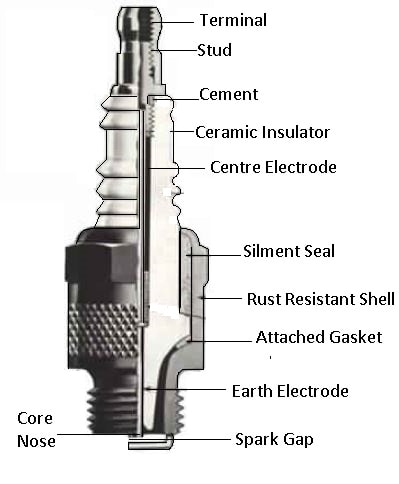
Parts of a Spark Plug
Following are the main parts of a spark plug:
- Centre electrode or insulated electrode.
- Earth electrode.
- Insulation separates the two electrodes.
- Terminal
- Shell
- Stud
- Contact spring
- Core nose
- Silment seal
- Rust-resistant shell
- Ceramic insulator
Description of Parts
The upper end of the center electrode is connected to the spark plug terminal, where the H.T. cable from the ignition coil is connected and surrounded by a porcelain insulator.
The below half portion of the insulator is fastened with a metal shell. The lower portion of the shell has a short electrode attached to one side and bent in towards the center electrode so that there is a gap between the two electrodes.

The two electrodes are thus separated by the insulator. The sealing gaskets are provided between the insulator and the shell to prevent the escape of gases under various temperature and pressure conditions.
The lower part of the shell has screw threads and the upper part is made in a hexagonal shape like a nut so that the spark plug may be screwed in or unscrewed from the cylinder head.
In other designs, a tapered fir is used. Some spark plugs are provided with a built-in resistor, which forms part of the center electrode. The resistor serves two purposes:
- It reduces radio and television interference from the ignition system.
- It reduces spark plug electrode erosion caused by excessively long sparking.
Read also: Fuel Pump: Types of Fuel Pump, Working Principle
Types of Spark Plugs
Following are the main types of spark plugs:
- Copper spark plugs
- Platinum spark plugs
- Iridium spark plugs
- Double platinum spark plugs
- Plustar spark plugs
- Silver spark plugs
#1 Copper Spark Plugs
These types of spark plugs are very popular nowadays. As the name suggests, these spark plugs have a copper core and use a nickel alloy at the working end of the electrode that generates the spark.
Since both nickel and copper have relatively low melting points, the edge of these electrodes wears out quickly, resulting in a gap as small as 10,000 miles. This leads to misfires, reduced gas mileage, and damage to coils and ignition wires. Most high-performance vehicles are built with this spark plug because of its efficiency.
#2 Platinum Spark Plugs
Platinum spark plugs typically have a platinum disc at the end of the electrode tip, which protects the electrode edge with its high melting point. Platinum is a precious metal which makes these spark plugs very expensive.
These spark plugs feature long life, typically 30-40 thousand miles, and are hotter than copper type. Platinum metal is quite hard, resulting in increased durability of spark plugs. platinum spark plugs are more resistant to carbon buildup.
#3 Iridium Spark Plugs
Iridium is a more rigid metal than platinum and has an even higher melting point, allowing these spark plugs to last about 25% longer than platinum-type spark plugs. When high power output from the engine is required, iridium spark plugs are used.
Since they have a smaller electrode tip diameter, which increases spark efficiency and improves engine function. They provide a very efficient spark, thus ensuring complete combustion and running the engine smoothly. Due to their high cost, they are less likely to be used.
#4 Double Platinum Spark Plugs
They are similar to platinum spark plugs, but the only difference is that both their electrodes are made of platinum, i.e. the ground electrode as well as the center electrode, both are made of platinum.
#5 Plustar Spark Plugs
Plustar plugs create a high-intensity electrical pulse by adding an internal capacitor TP stores energy and releases, it beyond the benefits of conventional plugs.
It uses pulsed electricity technology to convert a small portion of the gaseous air-fuel mixture into a highly excited plasma that ignites instantly and burns quickly. This offers a more powerful and consistent engine that starts quickly, idles smoothly, generates more torque, uses less fuel, and emits less.
#6 Silver Spark Plugs
As the name suggests, spark plugs are made using silver metal. They are known for high performance and excellent thermal conductivity. This type of spark plug is commonly used in European high-performance vintage cars and motorcycle engines.
Despite their advantages, they have a short lifespan and low durability. These spark plugs are further classified into two types based on the amount of heat dissipation and operating temperature. They are described below.
- Hot spark plug.
- Cold spark plug.
#1 Hot Spark Plug
Heat range is a means of designating how hot a plug will run in operation. It refers to the ability of the spark plug to heat transfer from the firing tip of the insulator to the cooling system of the engine.
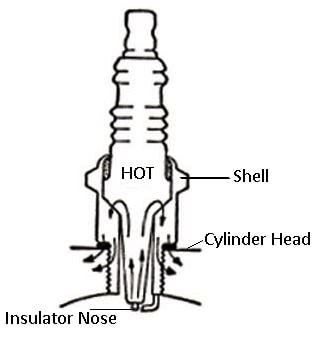
The temperature that a spark plug will attain depends upon the distance through which the heat is transferred. If the oath of heat travel is long, the plug will run hotter than if the path is short.
This types of spark plug have a longer path of heat travel and run hotter than the cold spark plug which has a
#2 Cold spark plug
These types of spark plugs are used in the heavy-duty continuous running high-speed engine to avoid overheating. When a plug runs tool cold, the carbon deposits on the insulator around the center electrode.
A hotter running plug will burn this carbon away and prevent its formation. A plug that runs hot will wear more rapidly since the high temperature causes the electrode to burn away more quickly.
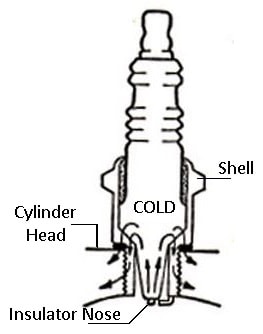
If a plug runs too hot, the insulator may take on a white or greyish cast and may appear blistered. Low-speed, medium-duty engines running at colder operating conditions require a hot spark plug.
Different engines working in various conditions need a plug having a specific heat range, and a manufacturer producing plugs in several heat ranges. In between the hot and cold spark plugs, medium hot and medium cold spark plugs are also available to suit the specific condition of the engine.
The projected core nose type of plug has the plug tip cooled by the incoming charge at high engine speeds, enabling the plug to run hotter at low speeds so extending the heat range.
Working of Spark Plug
How does a spark plug work?
The use of the spark plug is to produce an electric spark to ignite the compressed air-fuel mixture inside the engine cylinder. It must produce the spark at the correct movement at the end of the compression stroke.
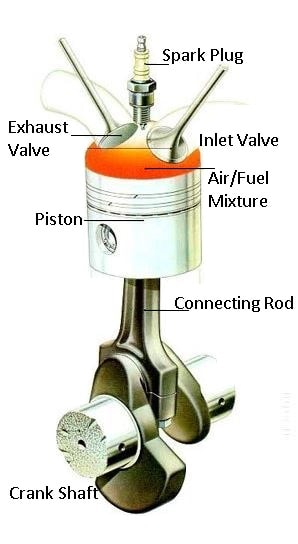
A proper gap is to be maintained between the two electrodes of the spark plug so that the sparking may take place. When the spark plug is screwed into the cylinder head, the ground electrode is said to be connected with the ground.
The terminal of the center electrode is directly connected with the H.T. lead of the ignition coil in the case of a single-cylinder engine, or through the distributor in the case of a
The secondary circuit of the electrical system is to be completed through the gap between the electrodes. When the H.T. current passes through the circuit, it jumps the gap producing a spark, which ignites the compressed air-fuel mixture in the cylinder.
Read also: What is Muffler? How it works?
Material Used In Spark Plugs
The materials used in the construction of different parts of a spark plug are as follows:
- Shell and Steel.
- Insulation: Porcelain, mica, sintered alumina. The porcelain has disadvantages of brittleness and low resistance to thermal shocks. Mica is somewhat attacked by fuels. Sintered alumina is now almost extensively used for insulation.
- Electrode: Nickel, an alloy of nickel and manganese, the alloy of nickel, manganese, and silicon. In platinum alloy, the addition of manganese (2*5-3*5%) improves tensile strength and resistance to sulfur attack at high temperatures. Platinum alloys are better for electrodes, but their high cost limits their use.
Read Also: What are different mechanical properties of materials?
How to Clean the Spark Plug
Due to the combustion of fuel in the cylinder, carbon particles are deposited on and around the electrodes, which not only reduces the plug gap but also prevents the spark to occur. If the spark is still occurring.
It is too weak that it cannot ignite the fuel. Hence the spark plug is to be cleaned. There is no specific period after the plug is cleaned. It depends upon the carbon deposits which can take place due to any reason like nature of the fuel, mixture strength, lubricating oil, etc.
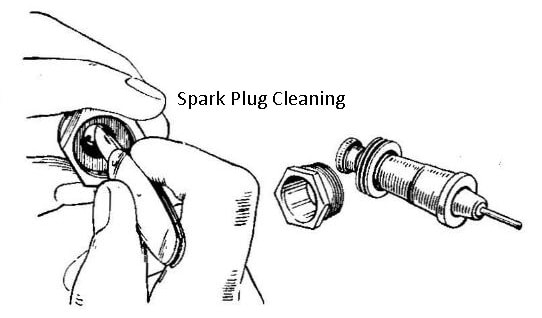
The spark plug can be cleaned either by sandpaper or by sandblasting. For this purpose, remove it from the cylinder head, clean it, correct the gap, check carefully if any sand particle is sticking on it, and then fit it again in the cylinder head properly.
If the insulator or sealing is a broker, the spark plug should be replaced. The plug should be given an engine performance test after it is replaced in the cylinder. It should be checked carefully that the center electrode end is perfectly flat and not round. If it is round it should be filed flat and the gap adjusted to specification.
Spark Plug Gap
The gap between the center electrode and the ground electrode is called the spark plug gap. This gap is adjusted to the recommended specifications by bending the ground electrode. It varies from 0*4 mm to 1*0 mm.
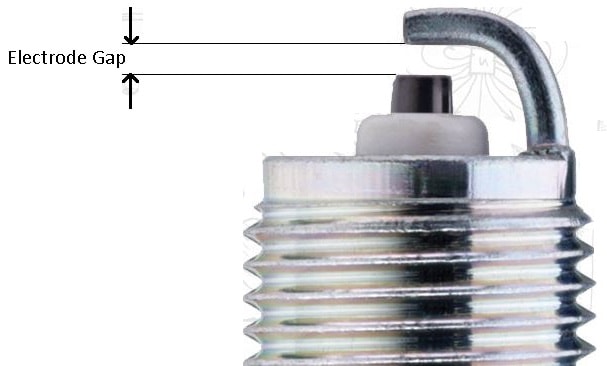
It is measured with a feeler gauge, The electrical resistance of the spark plug depends upon the nature and compression of the fuel mixture and also upon the gap. Too large or too small gap reduces the efficiency of the entire ignition system, which in turn causes losses in engine power and operating efficiency.
It is therefore of great importance to maintain the proper spark plug gap. No foreign materials, such as carbon, should be deposited on the electrodes, which will reduce the gap. Also, the electrodes should not corrode, which will increase the gap. The carbon deposited on the outside insulator between the plug terminal and the shell allows some of the high voltage currents to bypass the gap.
This is between the intensity of the spark causing losses in combustion efficiency and a decrease in engine power. If the electrical leaks become excessive, the plug will not produce a spark at all. Cracked insulators are usually caused by the careless installation of the plug or by careless adjustment of the plug gap.
Why do Spark Plugs fail To Function?
A spark plug will fail in its function due to the following reasons:
- Spark fouled by engine oil entering the combustion chamber.
- Plug fouled by the too-rich mixture.
- The spark plug was badly covered with carbon from poor ignition.
- Plug gap incorrect.
- Burned electrodes or broken lower insulators are caused by overheating.
- Red, brown, or yellow oxide deposits on the plug interior.
- Accumulation of dirt or moisture on the outside of the insulator that short the plug by grounding the high voltage.
- cracked or broken insulator sealing.
Read also: What is clutch? How it works? and Types of clutch
Requirements of Good Spark Plugs
- A good spark plug must be able to function under all working conditions of temperature and pressure. It is designed to operate under 20,000 to 30,000 volts and withstand pressure as high as 600 psi.
- It must maintain the proper gap between two electrodes under all conditions.
- The seals of the spark plug must be able to withstand the high pressure and temperature created in the combustion chamber during the power strokes.
- The spark plug must offer very high resistance to current leakage.
- it must be perfectly gas-tight. Any leakage of hot gases will upset the normal steady state of the plug causing such a high temperature to be reached that the insulator and the electrode will disintegrate and fall into the cylinder.
- It must be corrosion-resistant.
- It must have proper reach into the combustion chamber Reach is the length of the threaded portion that enters the cylinder. If a long reach plug is fitted into a short reach hole, it will reduce the combustion space and increase the compression ratio. On the other hand, if a sort of reach plug is fitted into a long reach hole, it will increase the combustion space and reduce the compression ratio.
- It should have reduced interference to ratio and television from the ignition system.
- It should also reduce the electrode erosion caused by excessively long sparking.
Conclusion
That is it. Thanks for reading. If you have any questions about “types of spark plugs” you can ask in the comments. If you found this article helpful please share it with your friends.
Subscribe to our newsletter to get notification of our new articles:
Download PDF of this article:
Read also: What are different types of carburetors? How each types of carburetor works?
You may also like this:
- Why Are Spark Plugs So Important To Your Engine? | CBAC.com
- Spark Plug Replacement Service & Cost – YourMechanic
May i have the pdf file ?
Thank you
You’re welcome. The PDF file has been sent to your inbox.
My I have a pdf on the break down of all spark plug related characteristics.
Thank you!
The PDF file has been sent to your inbox.
May i have the pdf file. Thanks
You’re welcome. The PDF file has been sent to your inbox.
sir i need pdf of this file.
The PDF file has been sent to your inbox.
May i have the pdf file?
The PDF file has been sent to your inbox.
i want to download topic about spark plug but not accessing the pdf format please avail the format
I have updated the article with the PDF file. Now, you can download it.
Your notes are well arranged and are very easy to understand and ready
Thank you so much.
Good notes
Thank you